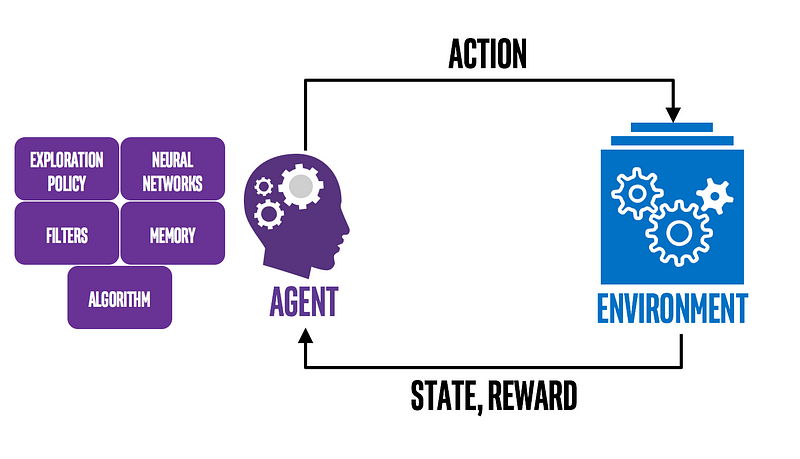Exploring Reinforcement Learning: The Future of Intelligent Systems
Written on
Understanding Reinforcement Learning
In the field of artificial intelligence, few approaches are as promising and intriguing as reinforcement learning (RL). This adaptable and dynamic machine learning methodology enables agents to learn optimal behaviors through trial and error, similar to how humans and animals learn from their experiences.

As AI capabilities progress, the role of reinforcement learning in shaping intelligent decision-making across various sectors becomes increasingly significant. This article aims to explore the complexities of reinforcement learning, its applications, challenges, and future prospects.
Key Concepts of Reinforcement Learning
At its core, reinforcement learning involves an agent that interacts with its environment, takes actions, and receives feedback in the form of rewards or penalties. The primary objective for the agent is to develop a policy—a strategic plan for choosing actions—that maximizes cumulative rewards over time. The essential components of reinforcement learning consist of:
- Agent: The entity that learns and makes decisions based on its environment interactions.
- Environment: The external context in which the agent operates and gets feedback.
- Actions: The possible moves or decisions available to the agent at any given moment.
- Rewards: Feedback signals indicating the desirability of the agent's actions.
- Policy: The strategy the agent follows to select actions based on its current state.
Applications of Reinforcement Learning
The adaptability of reinforcement learning has led to its implementation in numerous industries. Here are some noteworthy applications:
- Game Playing: RL algorithms have demonstrated exceptional success in mastering complex games like Go, chess, and video games, often exceeding human performance in strategic decision-making through iterative learning and exploration.
- Robotics: RL is crucial for enabling robots to autonomously learn from their interactions in the physical world, with applications ranging from robotic manipulation and navigation to tasks demanding dexterity, such as assembly and surgical procedures.
- Finance: In finance, reinforcement learning algorithms assist in portfolio management, algorithmic trading, and risk assessment, adapting to dynamic market conditions to optimize investment strategies and minimize risks.
- Healthcare: RL shows promise in areas such as personalized treatment planning, drug discovery, and medical image analysis, aiding clinicians in making informed decisions to enhance patient outcomes.

- Autonomous Vehicles: Self-driving cars utilize reinforcement learning to navigate intricate traffic situations, learn driving behaviors, and optimize routes for safe travel, adapting to changing road conditions for enhanced safety.
Challenges and Future Directions
Despite its achievements, reinforcement learning encounters several challenges that require attention from researchers and practitioners:
- Sample Efficiency: RL algorithms often need a substantial number of interactions with the environment to learn effective policies, leading to high sample complexity and resource demands.
- Robustness: RL agents may find it difficult to generalize learned behaviors to new or unseen environments, raising concerns about robustness and transferability.
- Exploration-Exploitation Trade-off: Balancing exploration (trying new actions to discover optimal strategies) with exploitation (using known strategies to maximize rewards) is a fundamental challenge in reinforcement learning.
- Ethical and Societal Implications: As RL systems are deployed in real-world scenarios, considerations around fairness, accountability, and transparency grow increasingly critical.
Looking ahead, the future of reinforcement learning presents ample opportunities for innovation. Ongoing research aims to tackle existing challenges and expand the frontiers of possibility. Areas of focus include:
- Algorithmic Advances: Creating more efficient and scalable RL algorithms that can learn from fewer samples and generalize across diverse environments.
- Interdisciplinary Collaboration: Merging insights from machine learning, cognitive science, and neuroscience to deepen our understanding of learning processes.
- Hybrid Approaches: Combining reinforcement learning with other AI methodologies, such as deep learning and imitation learning, to develop more robust systems.
- Real-World Deployment: Applying reinforcement learning to address pressing real-world issues in sectors like healthcare, sustainability, and education.
In summary, reinforcement learning is at the forefront of AI research, offering a powerful framework for learning and decision-making in complex environments. By integrating insights from neuroscience, computer science, and engineering, researchers and practitioners are on the verge of unlocking new possibilities in intelligent systems that can revolutionize industries and enhance lives. As we continue to explore the intricacies of reinforcement learning, the potential for innovation remains limitless.
This video introduces the fundamentals of reinforcement learning, covering key concepts and frameworks.
Explore how reinforcement learning can be applied to sequential decision-making with a data-driven approach.